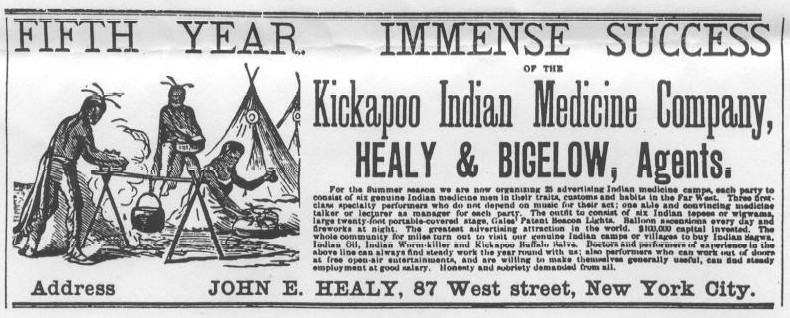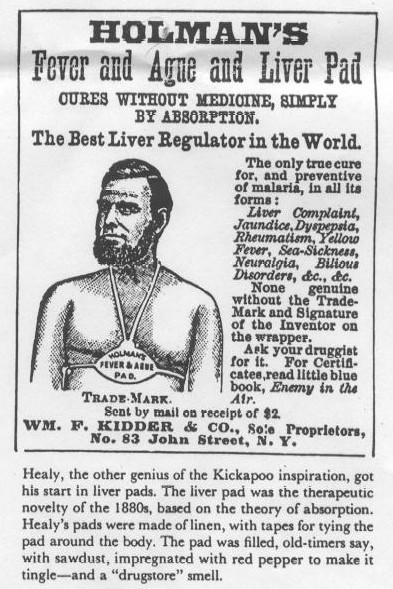Charley (Texas Charley) Bigelow, a farm boy from Beeviile, Bee
County, Texas- trader, bluffer, raconteur--thought up the rationalization
of the New Haven bottling plant. The white agents were simply acting for
the Indians. The little Kickapoo children gathered the precious leaves,
gums, oils, and berries from God's great laboratory, the fields, prairies,
and dark forests. The primitives then compounded the Sagwa, etc., and shipped
it east by fast freight, where it was going to be consumed anyway.
Healy, the other genius of the Kickapoo inspiration,
got his start in liver pads. The liver pad was the therapeutic novelty
of the 1880s, based on the theory of absorption. Healy's pads were made
of linen, with tapes for tying the pad around the body. The pad was filled,
old-timers say, with sawdust, impregnated with red pepper to make it tingle--and
a "drugstore" smell.

How a White Chief Made Big Medicine
Probably the most spectacular med shows of
the patent-medicine decades were the Healy and Bigelow Kickapoo Indian
galas. They capitalized on curiosity about the West and the vogue for Wild
West shows. Pawnee Bill--Major Gordon Lillie--is said to have got into
the Wild West show business through having delivered a clutch of reservation
Indians to the Kickapoo interests.
It had come suddenly to John E. Healy, a second-generation
Irishman born in New Haven, like an apocalyptic vision: Why not have Indian
herb medicines sold by the Indians themselves in an imaginative stage setting?
The Kickapoo road companies were the result, numbered from one up. They
consisted of a half-dozen Indians with their squaws and papooses and a
consulting doctor (the manager) who lectured on the merits of the preparations.
For years there were seventy-five or a hundred of these carnival companies,
known as the "Kicks" in the circus world. Each outfit carried a canvas
roof, scats for about five hundred spectators, and a side wall. Tepees
were erected on the "reservation." The manager's tent was placarded "Indian
agent." And that wasn't entirely fiction. When Doctor Laughing Dog got
into trouble over the price of a pint, it was the job of the "agent" to
straighten him out.
The performers were required to do two tums,
double in the afterpiece, and stick up bills during the morning. At first
Healy and Bigelow visualized the medicine as simmering in a pot inside
a tepee. But this was a lot of trouble. So the script was changed. Healy
and Bigelow became simply representatives of the Indians who happened to
be located in New Haven, Connecticut. The Plains Indians shipped their
dried essences to the Connecticut palefaces. There, just to help the Indians
out, the latter put the Sagwa and Indian Salve into handy packages. Why
did this honor fall to the small and obscure tribe of Kickapoos? No one
knows. Probably the name tickled Healy's sense of humor, which must have
been highly developed.
Kickapoo was big stuff for a while--until
the two partners got rich, that is. There was a full line of de-wormers,
salves, and stomachics, in addition to the Sagwa. All were strongly recommended
by Dr. Prairie Wolf and Little Bright Eyes.

Source: Gerald Carson: One For a Man, Two For a Horse, Doubleday
and co. NY 1961.
Note:
It appears that "Texas Charlie" and John E. Healy (born in New Haven)
became rich selling Kickapoo Indian "medicine". This was sold by Indian
road companies. They consisted of a half-dozen Indians with their squaws
and papooses and a consulting doctor (the manager) who lectured on the
merits of the preparations. For years there were seventy-five or a hundred
of these carnival companies know as the "Kicks" in the circus world. The
biographical information as to Bigelow being born in Beeville Texas, in
Mr. Carson's book would seem to be incorrect. Likely this information was
taken from period advertising, which might have been changed to capitalize
on Bigelow's association with the Old West.
References:
Front-page obituary "Houston Chronicle" December 31, 1917 provided
by Dallas Public Library.
"Collecting the West" (pg. 128) by Wm. Ketchtun
"One for a Man, Two for a Horse" (pg.62) by a G. Carson - photocopy
provided by Wm. Ketchurn.
Miscl. Information provided by Connecticut Historical Society, letter
dated 9/8/98.
"Buffalo's Bill's Wild West" by Wilson & Martin, (pg. 230-234).
Color plates of Texas Charlie engraved rifle, advertising and SSA pistol
from (.9) Wilson & Somberland's book on Colt Firearms.
"Sixguns" by Elmer Keith (pg. 148).
''The American West Magazine" 2/1967, Vol 4, No.1) Long article
on Kickapoo Medicine, Healy & Bigelow and Texas Charlie.
Information supplied by:
David T. Hulse
6992 S. CR 350 W
Clayton, IN 46118
Email: ThePines350@aol.com
go to page 3..........................................

